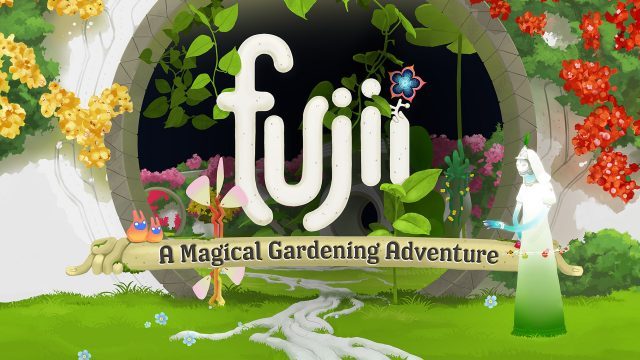Creating a VR that truly immerses the user is no easy feat. To pull this off correctly requires a careful blend of graphics, animations, audio, and haptics that work together in deliberate concert to suspend disbelief and engross the user. Fujii is a joyful interactive adventure and a masterclass in rich VR interactions. The President of Funktronic Labs, the studio behind the game, is here to tell us more about his design approach.
Guest Article by Eddie Lee Eddie Lee is the President and co-founder of Funktronic Labs, an LA-based independent game studio that focuses on delivering high-quality experiences through games, XR, and other interactive media. His experience spans nearly 15 years in the fields of graphics, game design, and computer simulations.
Today, we are thrilled to pull back the curtain and give you an inside look into our thought processing while developing Fujii, a title that has been a labor of love for us at Funktronic Labs. As the landscape of virtual reality continues its dynamic evolution, we saw a golden opportunity not just to adapt, but to breathe new life into Fujii. We’re eager to re-introduce our experience to a burgeoning new community of VR enthusiasts. Stick with us as we delve into the design process that originally brought this magical floral adventure to life.
A Brief Foray into Funktronic Labs


Fujii – A Harmonious Blend of Nature and Technology
Fujii first made its debut as an auteur, art-focused launch title for the release of Quest 1 in May 2019. This project holds a special place in our hearts as a resonant blend of artistic vision and interactive design, exploring the wonders of humanity’s connection with nature. Conceived as a soulful sojourn, Fujii interweaves the realms of nature exploration and whimsical gardening, creating an interactive meditative space for players to lose themselves in.
In an industry landscape where unconventional, art-focused projects often struggle to find support, we were extraordinarily fortunate to connect with Meta (at the time known as Oculus). Recognizing the artistic merit and unique potential in our vision, they granted us the exceptional opportunity and support to bring this artsy-fartsy, non-core experience to fruition.
Fujii’s Overall Design Philosophy
During Fujii’s development, we were acutely aware that a substantial portion of our audience would be stepping into the realm of VR for the first time via the Quest 1—the industry’s first major standalone 6DoF headset.
This keen insight significantly sculpted our design approach. We opted for intuitive, physics-driven interactions that mirror the tactile simplicity of the natural world, consciously avoiding complex VR interactions, elaborate interfaces or dense text.
By refraining from controls that demand steep learning curves, we zeroed in on cultivating immediate, natural interactions, thereby offering a warm invitation to VR newcomers of all ages and gameplay experience. Remarkably, this has led to an incredibly diverse player base, attracting everyone from young children to the elderly, many of whom have found Fujii to be an accessible and joyous experience. [Editor’s note: we quite liked the game too].
VR as a New Interaction Paradigm
It’s an oversimplification to regard VR as merely a ‘stereoscopic monitor strapped to your face.’ We see it as much more than just a visual spectacle; VR introduces a groundbreaking paradigm shift in user interaction. With its 6DoF capabilities, VR transcends conventional gaming by enabling intuitive physical actions like grabbing, touching, and gesturing.
This new paradigm unlocks a whole new layer of tactile engagement and immersion, connecting players directly with their virtual surroundings. This stands in contrast to the abstract, button-press or cursor interactions that characterize traditional, non-VR games. In essence, VR offers a far more integrated and visceral form of engagement, elevating the gaming experience to a whole new level.
Physics-based Inventory
In the realm of VR, the addition of physics and animations to objects isn’t just aesthetic; it serves as a vital conduit for player engagement and understanding. The enjoyment derived from physics-based interactions comes from the brain’s innate satisfaction in grasping the object’s physical properties—be it weight, drag, or inertia.
Absent these nuanced physics, interactions feel insubstantial and weightless, breaking the immersive spell. As a guiding principle, consider incorporating physics into every touchpoint, enriching the player’s tactile connection to the game world and making interactions incredibly rewarding.
To illustrate, let’s delve into the inventory system in Fujii. Far from being a mere menu or grid, our inventory system is organically woven into the fabric of the game’s universe. We’ve opted for a physically-driven inventory, where items like seeds find their homes in “natural slots” in the virtual environment, echoing real-world interactions.
This design choice is not only intuitive but negates the need for a separate tutorial. To further enhance this connection, we’ve enriched these interactions with animations and robust physics feedback, providing an additional layer of tangibility that helps players more fully connect with their virtual environment.
Plants and Touch
Another compelling instance of the importance of physics-based design in VR can be found in our intricate interaction model for plants within Fujii. Human interaction with plants is often tactile and visceral; we touch, we feel, we connect. Our aim was to preserve that authentic texture and intimacy in a virtual context. But we went a step further by infusing every plant with musical responsiveness, adding an ethereal layer of magic and wonder to your botanical encounters.
In Fujii, each interaction with plant life is designed to resonate on a meaningful level. Every plant, leaf, and stem adheres to its own tailored set of physics rules. Whether it’s the gentle sway of a leaf in response to your touch or the subtle recoil of a stem, our objective has been to make these virtual interactions indistinguishable from real-life ones.
Achieving this required painstaking attention to detail, coupled with robust physics simulations, ensuring that each touch aligns with natural expectations, thereby deepening your immersion in this magical realm.
Watering
Watering plants in Fujii isn’t just a game mechanic; it’s crafted to be a tactile and immersive VR experience that mimics the soothing and nurturing act of watering real plants. From the way the water cascades to how it nourishes the flora, every detail has been considered. Even the extension of your arms into playful, jiggly water hoses has been designed to offer a sense of whimsy while maintaining an air of naturalism. The water interacts realistically with both the plants and the landscape, underlining the game’s commitment to intuitive, lifelike design.
To infuse an additional layer of enchantment into this seemingly simple act, we’ve introduced a delightful touch: any water droplets that fall onto the ground trigger a temporary, flower-sprouting animation. This whimsical feature serves to amplify the ‘reality’ of the droplets, allowing them to interact with the world in a way that grounds them.
The Symphony of Sound Design
In Fujii, sound design is far from peripheral; it’s an integral facet of the game’s immersive landscape. Sound doesn’t merely serve as an auditory backdrop; it plays a pivotal role in how humans subconsciously interpret the physical makeup of the objects they interact with.
When sound, physics, and visuals synergize, they allow the brain to construct a comprehensive mental model of the object’s material properties. Numerous studies have even demonstrated that superior sound design can elevate players’ perception of the graphics, making them appear more lifelike, despite no actual change in visual quality (see this and this).
Seizing this opportunity, we’ve added a unique aural dimension to Fujii. Instead of sticking strictly to realistic, organic sounds, we’ve imbued interactions with melody, notes, and keys, creating an atmosphere of musical exploration and wonder. It’s as if you’re navigating through a symphonic wonderland, amplifying the sense of enchantment and, ideally, offering players a synesthetic experience that enriches their immersion in this captivating virtual world.
Trust the Design Process
In the course of game development, we’ve learned that it’s often impractical, if not impossible, to map out every component of a game’s design during pre-production. Instead, we’ve increasingly embraced a mindset of ‘discovery’ rather than ‘invention’.
While we adhere to certain design principles, the elusive process of ‘finding the fun’ in a VR experience continues to be a mystifying yet exciting challenge, even with over a decade of experience under our belts. The magic often unfolds when the game seems to take on a life of its own, almost as if it wishes to manifest itself in a particular way.
To best facilitate this organic process, we’ve found that maintaining a high degree of flexibility and adopting an iterative mindset is crucial—especially in VR development, where ideas don’t always translate well into enjoyable VR interactions.
Take, for example, the design of our watering mechanic (from earlier): initial concepts like grabbable watering cans or throwable water orbs seemed engaging on paper but fell flat in practice. It wasn’t until we stumbled upon the random idea of water shooting magically from the player’s hands that everything seemed to click into place. Allowing room for such iterative spontaneity has often led us to unexpected yet delightful game mechanics.
– – — – –
In the development of Fujii, our aim was to establish a meaningful benchmark for what can be achieved through simple yet thoughtful interaction design in VR. As technology marches forward, we anticipate that the fidelity of these virtual experiences will continue to gain depth and realism. Yet, the essence of our objective remains constant: to forge not just visually impressive virtual landscapes, but also highly interactive and emotionally resonant experiences.
We hope this in-depth technical exploration has offered you valuable insights into the thought process that go into shaping a VR experience like Fujii. As we continue on this journey, we invite you to explore and to keep your faith in the limitless possibilities that VR offers. Thank you for sharing this journey with us.
Fujii – A Magical Gardening Adventure is now available at the new low price of $10 on Meta Quest, SteamVR and PSVR 1.








